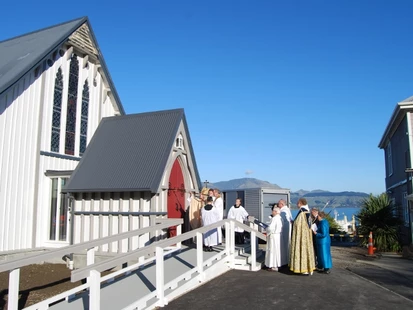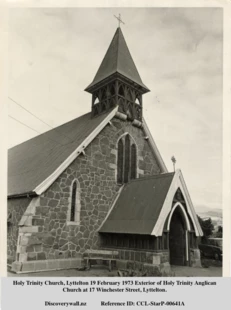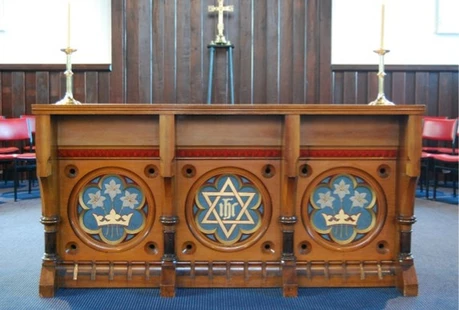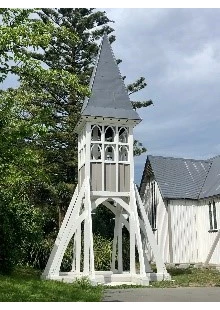H) St Saviour’s at Holy Trinity
Having viewed St Joseph’s, if you now look behind you, across the road you will see our next historic building.
It was felt by the settlers that an Anglican Church was needed in Lyttelton and the Church of the Most Holy Trinity was built from green wood in 1852. However, as the timber dried, it quickly became too unsafe to use and was demolished in 1857.
It was replaced in 1860 by a new church built from red volcanic stone from the hills near Lyttelton and sandstone from Quail Island. It was the first stone Anglican church built in Canterbury. It in-corporated steel and timber, including some from the original church. The interior featured plaster stucco and stained matai, with totara and pine seats.
It was destroyed in the 2011 earthquakes though a major effort was made to rescue many original stained-glass windows, timbers and items including the full church organ and pipes.
Another place of worship, St Saviours Chapel was built in 1885 at Lyttelton West. Built as a seafarers’ church its most famous visitors included Robert Falcon Scott and his crews from the Discovery and Terra Nova expeditions. Generations of seafarers worshipped here, but eventually it was no longer needed by the community and was moved, in sections, to Cathedral Grammar School in Christchurch in 1976.
The churches became intertwined in 2013 when St Saviours chapel became too small for the school’s needs and so it was offered back to Lyttelton. Given that Holy Trinity had yet to be rebuilt following the earthquakes, it was the perfect opportunity and the chapel came home to Lyttelton (over Dyers Pass/Pukeatua in three sections). It was re-erected on the Trinity site and items rescued from Holy Trinity were incorporated into St Saviours.
It was consecrated in 2015 and renamed St Saviour’s at Holy Trinity.
Next to the church stands The Mariners bell tower which houses the Seafarers bell brought over from England in the 1800s and rescued from the earthquake damaged church in 2011. It was blessed in 2020 and rings every Sunday. It tolls on Anzac Day, one for each of our fallen.
As a point of interest, the alter of St Saviours now resides in the Chapel of the Snows. This is a non-denominational Christian Church at McMurdo Station, Ross Island in Antarctica.
Go to the next building Dr Upham's House
Photographs from and further information http://www.lytteltonmuseum.co.nz/st-saviours-at-holy-trinity
For more Historic Sites, download the Lyttelton - Antarctic Brochure & Heritage of Lyttelton Harbour Brochure




